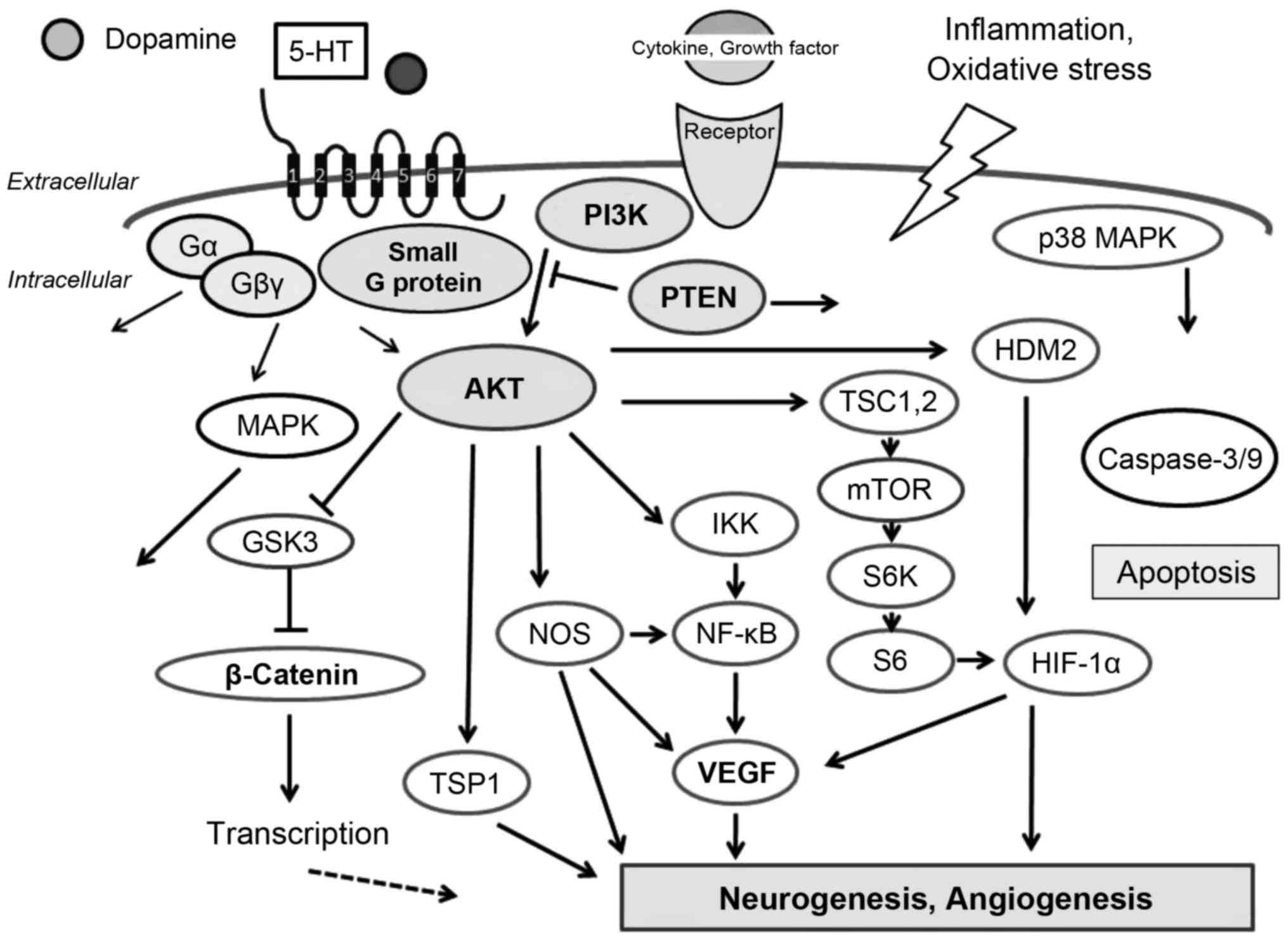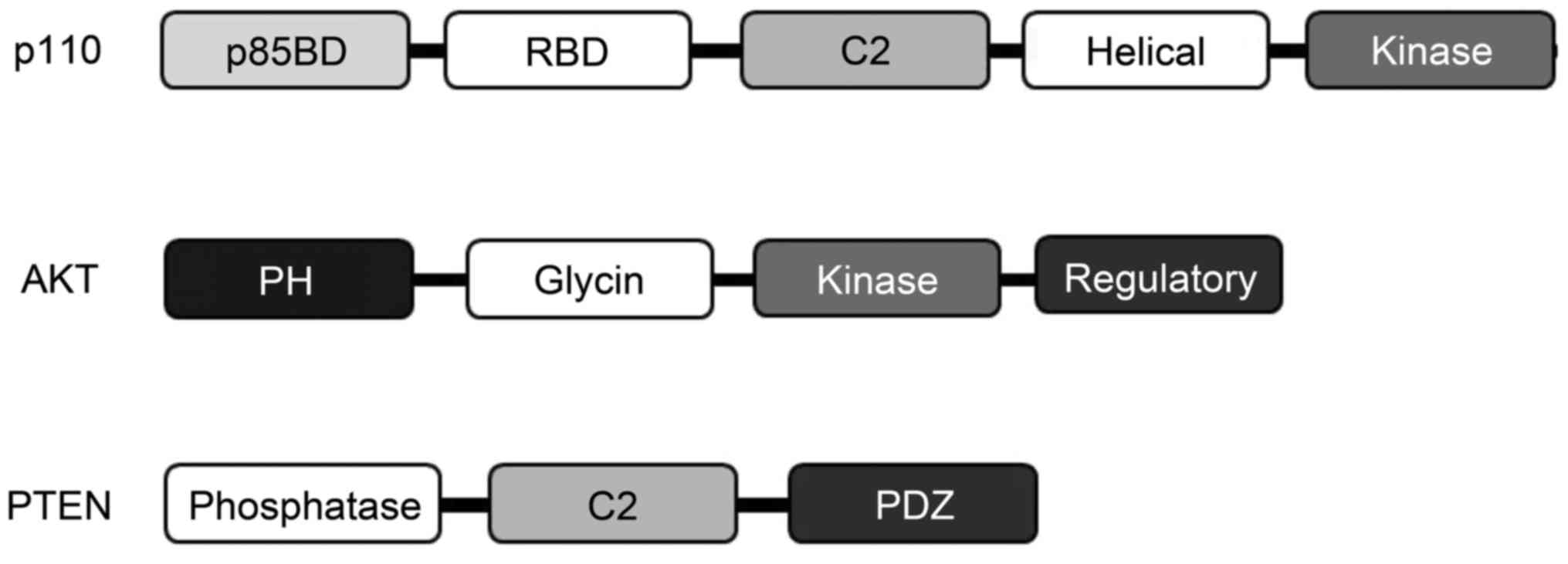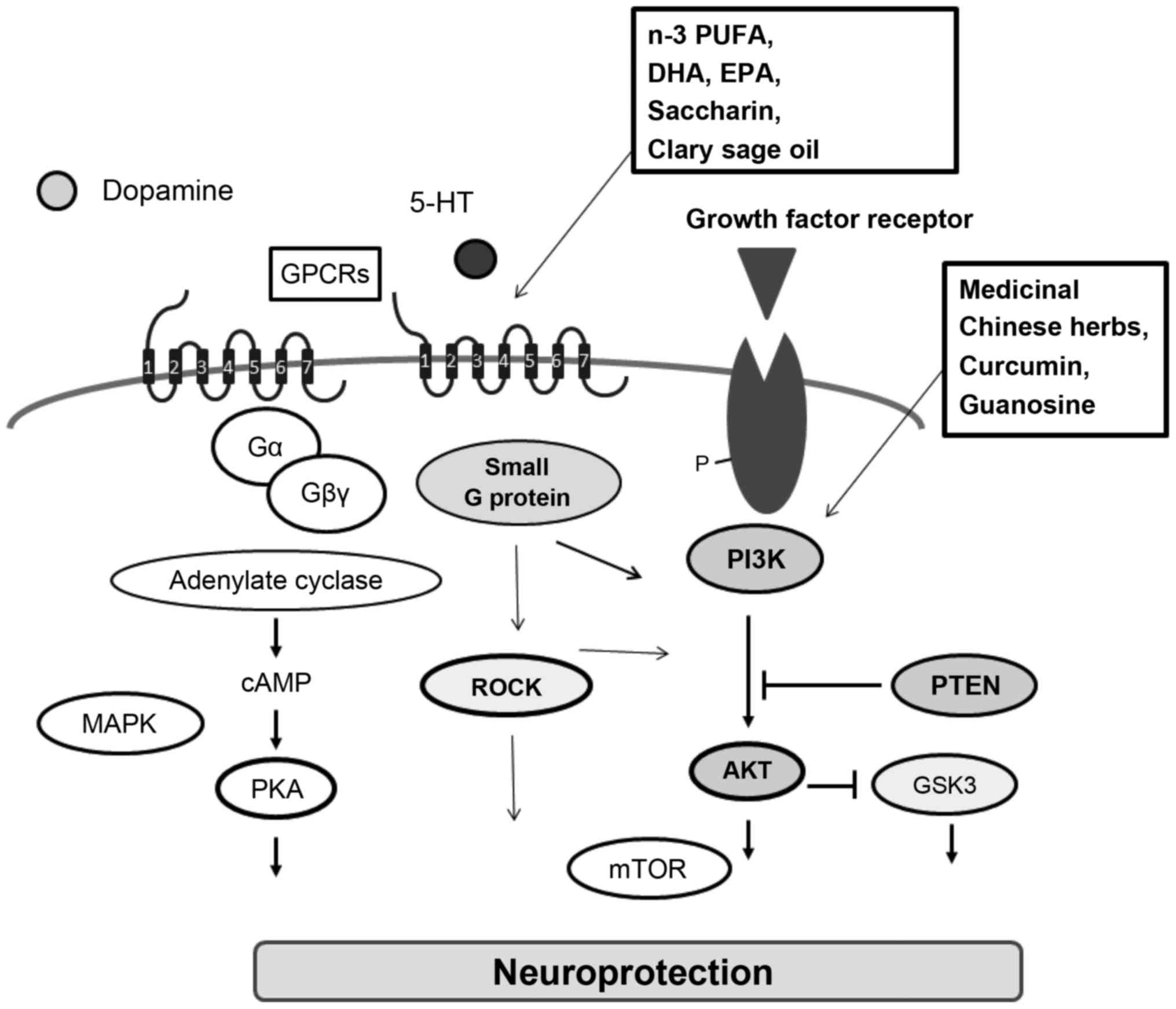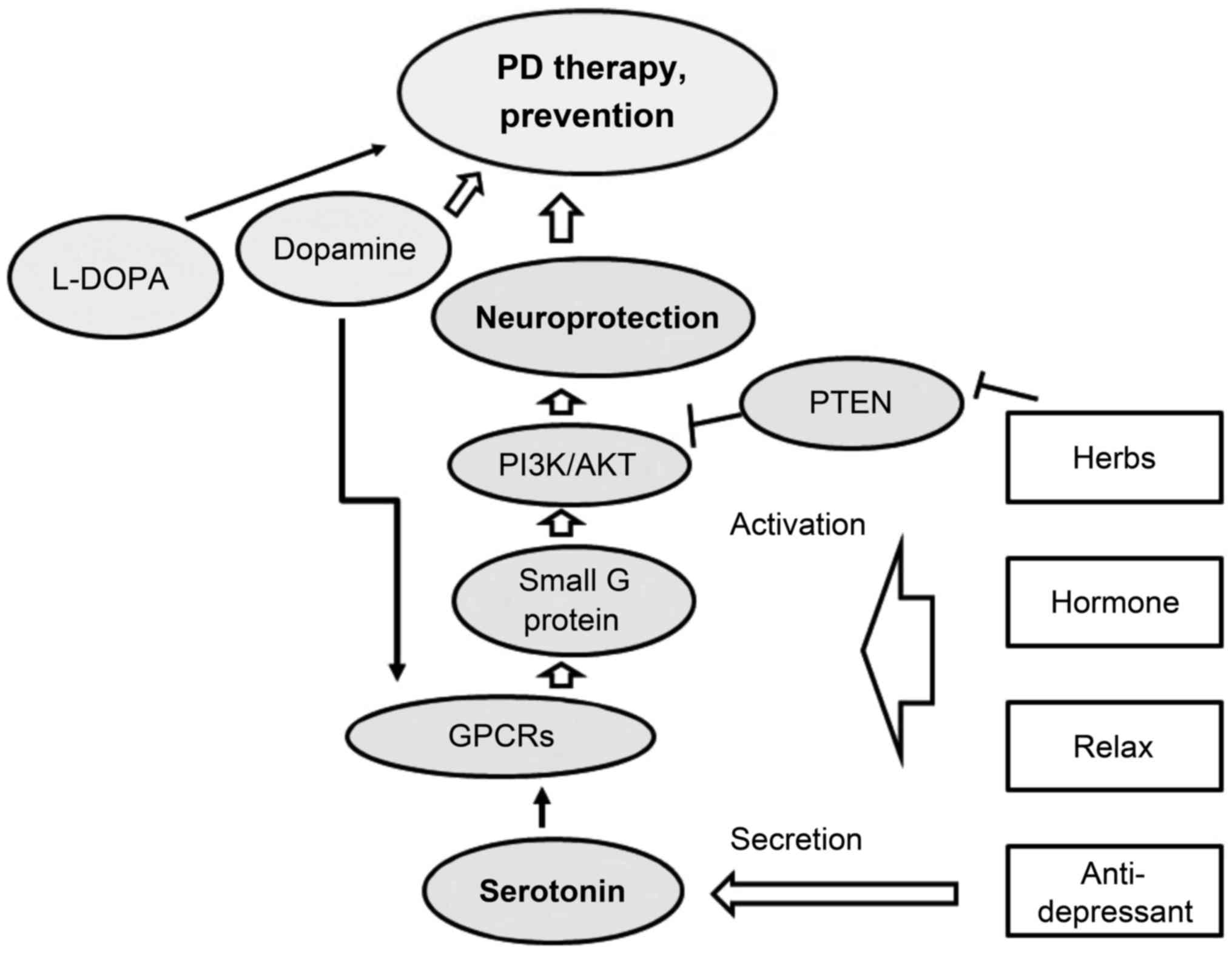PI3K/AKT signaling mediated by G protein‑coupled receptors is involved in neurodegenerative Parkinson's disease (Review)
- Authors:
- Noriko Nakano
- Satoru Matsuda
- Mayuko Ichimura
- Akari Minami
- Mako Ogino
- Toshiyuki Murai
- Yasuko Kitagishi
-
Affiliations: Department of Food Science and Nutrition, Nara Women's University, Kita‑Uoya Nishimachi, Nara 630‑8506, Japan, Department of Microbiology and Immunology, Graduate School of Medicine, Osaka University, Suita 565‑0871, Japan - Published online on: December 16, 2016 https://doi.org/10.3892/ijmm.2016.2833
- Pages: 253-260
This article is mentioned in:
Abstract
 |
 |
 |
 |
|
Armento ME, Stanley MA, Marsh L, Kunik ME, York MK, Bush AL and Calleo JS: Cognitive behavioral therapy for depression and anxiety in Parkinson's disease: A clinical review. J Parkinsons Dis. 2:135–151. 2012.PubMed/NCBI | |
|
Jagmag SA, Tripathi N, Shukla SD, Maiti S and Khurana S: Evaluation of models of Parkinson's disease. Front Neurosci. 9:5032016. View Article : Google Scholar : PubMed/NCBI | |
|
Luo Y, Hoffer A, Hoffer B and Qi X: Mitochondria: A therapeutic target for Parkinson's disease? Int J Mol Sci. 16:20704–20730. 2015. View Article : Google Scholar : PubMed/NCBI | |
|
Giráldez-Pérez R, Antolín-Vallespín M, Muñoz M and Sánchez-Capelo A: Models of α-synuclein aggregation in Parkinson's disease. Acta Neuropathol Commun. 2:1762014. View Article : Google Scholar | |
|
Kim WS, Kågedal K and Halliday GM: Alpha-synuclein biology in Lewy body diseases. Alzheimers Res Ther. 6:732014. View Article : Google Scholar | |
|
Tokuhira N, Kitagishi Y, Suzuki M, Minami A, Nakanishi A, Ono Y, Kobayashi K, Matsuda S and Ogura Y: PI3K/AKT/PTEN pathway as a target for Crohn's disease therapy (Review). Int J Mol Med. 35:10–16. 2015. | |
|
Nakanishi A, Wada Y, Kitagishi Y and Matsuda S: Link between PI3K/AKT/PTEN pathway and NOX protein in diseases. Aging Dis. 5:203–211. 2014. View Article : Google Scholar : PubMed/NCBI | |
|
Huang JS, Cho CY, Hong CC, Yan MD, Hsieh MC, Lay JD, Lai GM, Cheng AL and Chuang SE: Oxidative stress enhances Axl-mediated cell migration through an Akt1/Rac1-dependent mechanism. Free Radic Biol Med. 65:1246–1256. 2013. View Article : Google Scholar : PubMed/NCBI | |
|
Luo H, Yang Y, Duan J, Wu P, Jiang Q and Xu C: PTEN-regulated AKT/FoxO3a/Bim signaling contributes to reactive oxygen species-mediated apoptosis in selenite-treated colorectal cancer cells. Cell Death Dis. 4:e4812013. View Article : Google Scholar : PubMed/NCBI | |
|
Maiese K, Chong ZZ, Wang S and Shang YC: Oxidant stress and signal transduction in the nervous system with the PI3-K, Akt, and mTOR cascade. Int J Mol Sci. 13:13830–13866. 2012. View Article : Google Scholar : PubMed/NCBI | |
|
Ma Y, Zhao P, Zhu J, Yan C, Li L, Zhang H, Zhang M, Gao X and Fan X: Naoxintong protects primary neurons from oxygen-glucose deprivation/reoxygenation induced injury through PI3K-Akt signaling pathway. Evid Based Complement Alternat Med. 2016:58159462016. View Article : Google Scholar : PubMed/NCBI | |
|
Flor PJ and Acher FC: Orthosteric versus allosteric GPCR activation: The great challenge of group-III mGluRs. Biochem Pharmacol. 84:414–424. 2012. View Article : Google Scholar : PubMed/NCBI | |
|
Bohn LM, Gainetdinov RR and Caron MG: G protein-coupled receptor kinase/beta-arrestin systems and drugs of abuse: Psychostimulant and opiate studies in knockout mice. Neuromolecular Med. 5:41–50. 2004. View Article : Google Scholar : PubMed/NCBI | |
|
Bhattacharya M, Babwah AV and Ferguson SS: Small GTP-binding protein-coupled receptors. Biochem Soc Trans. 32:1040–1044. 2004. View Article : Google Scholar : PubMed/NCBI | |
|
Lu CY, Yang YC, Li CC, Liu KL, Lii CK and Chen HW: Andrographolide inhibits TNFα-induced ICAM-1 expression via suppression of NADPH oxidase activation and induction of HO-1 and GCLM expression through the PI3K/Akt/Nrf2 and PI3K/Akt/AP-1 pathways in human endothelial cells. Biochem Pharmacol. 91:40–50. 2014. View Article : Google Scholar : PubMed/NCBI | |
|
Song S, Zhou F and Chen WR: Low-level laser therapy regulates microglial function through Src-mediated signaling pathways: Implications for neurodegenerative diseases. J Neuroinflammation. 9:2192012. View Article : Google Scholar : PubMed/NCBI | |
|
Akagi T, Murata K, Shishido T and Hanafusa H: v-Crk activates the phosphoinositide 3-kinase/AKT pathway by utilizing focal adhesion kinase and H-Ras. Mol Cell Biol. 22:7015–7023. 2002. View Article : Google Scholar : PubMed/NCBI | |
|
Ballou LM, Chattopadhyay M, Li Y, Scarlata S and Lin RZ: Galphaq binds to p110alpha/p85alpha phosphoinositide 3-kinase and displaces Ras. Biochem J. 394:557–562. 2006. View Article : Google Scholar : | |
|
Fritsch R, de Krijger I, Fritsch K, George R, Reason B, Kumar MS, Diefenbacher M, Stamp G and Downward J: Ras and Rho families of GTPases directly regulate distinct phosphoinositide 3-kinase isoforms. Cell. 153:1050–1063. 2013. View Article : Google Scholar : PubMed/NCBI | |
|
Dale LB, Bhattacharya M, Anborgh PH, Murdoch B, Bhatia M, Nakanishi S and Ferguson SS: G protein-coupled receptor kinase-mediated desensitization of metabotropic glutamate receptor 1A protects against cell death. J Biol Chem. 275:38213–38220. 2000. View Article : Google Scholar : PubMed/NCBI | |
|
Suire S, Lécureuil C, Anderson KE, Damoulakis G, Niewczas I, Davidson K, Guillou H, Pan D, Clark J, Stephens L and Hawkins PT: GPCR activation of Ras and PI3Kc in neutrophils depends on PLCβ2/β3 and the RasGEF RasGRP4. EMBO J. 31:3118–3129. 2012. View Article : Google Scholar : PubMed/NCBI | |
|
Xu CL, Wang JZ, Xia XP, Pan CW, Shao XX, Xia SL, Yang SX and Zheng B: Rab11-FIP2 promotes colorectal cancer migration and invasion by regulating PI3K/AKT/MMP7 signaling pathway. Biochem Biophys Res Commun. 470:397–404. 2016. View Article : Google Scholar : PubMed/NCBI | |
|
Shi GX, Cai W and Andres DA: Rit subfamily small GTPases: Regulators in neuronal differentiation and survival. Cell Signal. 25:2060–2068. 2013. View Article : Google Scholar : PubMed/NCBI | |
|
Julian L and Olson MF: Rho-associated coiled-coil containing kinases (ROCK): Structure, regulation, and functions. Small GTPases. 5:e298462014. View Article : Google Scholar : PubMed/NCBI | |
|
Uehara R, Hosoya H and Mabuchi I: In vivo phosphorylation of regulatory light chain of myosin II in sea urchin eggs and its role in controlling myosin localization and function during cytokinesis. Cell Motil Cytoskeleton. 65:100–115. 2008. View Article : Google Scholar | |
|
Koyanagi M, Takahashi J, Arakawa Y, Doi D, Fukuda H, Hayashi H, Narumiya S and Hashimoto N: Inhibition of the Rho/ROCK pathway reduces apoptosis during transplantation of embryonic stem cell-derived neural precursors. J Neurosci Res. 86:270–280. 2008. View Article : Google Scholar | |
|
Li G, Liu L, Shan C, Cheng Q, Budhraja A, Zhou T, Cui H and Gao N: RhoA/ROCK/PTEN signaling is involved in AT-101-mediated apoptosis in human leukemia cells in vitro and in vivo. Cell Death Dis. 5:e9982014. View Article : Google Scholar : PubMed/NCBI | |
|
Yang S and Kim HM: The RhoA-ROCK-PTEN pathway as a molecular switch for anchorage dependent cell behavior. Biomaterials. 33:2902–2915. 2012. View Article : Google Scholar : PubMed/NCBI | |
|
Song H and Gao D: Fasudil, a Rho-associated protein kinase inhibitor, attenuates retinal ischemia and reperfusion injury in rats. Int J Mol Med. 28:193–198. 2011.PubMed/NCBI | |
|
Man JH, Liang B, Gu YX, Zhou T, Li AL, Li T, Jin BF, Bai B, Zhang HY, Zhang WN, et al: Gankyrin plays an essential role in Ras-induced tumorigenesis through regulation of the RhoA/ROCK pathway in mammalian cells. J Clin Invest. 120:2829–2841. 2010. View Article : Google Scholar : PubMed/NCBI | |
|
Rodriguez-Viciana P, Warne PH, Dhand R, Vanhaesebroeck B, Gout I, Fry MJ, Waterfield MD and Downward J: Phosphatidylinositol-3-OH kinase as a direct target of Ras. Nature. 370:527–532. 1994. View Article : Google Scholar : PubMed/NCBI | |
|
Chu JM, Chen LW, Chan YS and Yung KK: Neuroprotective effects of neurokinin receptor one in dopaminergic neurons are mediated through Akt/PKB cell signaling pathway. Neuropharmacology. 61:1389–1398. 2011. View Article : Google Scholar : PubMed/NCBI | |
|
Saunders C, Siuta M, Robertson SD, Davis AR, Sauer J, Matthies HJ, Gresch PJ, Airey DC, Lindsley CW, Schetz JA, et al: Neuronal ablation of p-Akt at Ser473 leads to altered 5-HT1A/2A receptor function. Neurochem Int. 73:113–121. 2014. View Article : Google Scholar : | |
|
Dizeyi N, Hedlund P, Bjartell A, Tinzl M, Austild-Taskén K and Abrahamsson PA: Serotonin activates MAP kinase and PI3K/Akt signaling pathways in prostate cancer cell lines. Urol Oncol. 29:436–445. 2011. View Article : Google Scholar | |
|
Gil S, Park C, Lee J and Koh H: The roles of striatal serotonin and L-amino-acid decarboxylase on L-DOPA-induced dyskinesia in a hemiparkinsonian rat model. Cell Mol Neurobiol. 30:817–825. 2010. View Article : Google Scholar : PubMed/NCBI | |
|
Mazzucchi S, Frosini D, Ripoli A, Nicoletti V, Linsalata G, Bonuccelli U and Ceravolo R: Serotonergic antidepressant drugs and L-dopa-induced dyskinesias in Parkinson's disease. Acta Neurol Scand. 131:191–195. 2015. | |
|
Chan RJ, McBride AW and Crabb DW: Seven transmembrane domain receptor subtypes identified in NG108-15 cells by reverse transcription-polymerase chain reaction. Biochem Biophys Res Commun. 205:1311–1317. 1994. View Article : Google Scholar : PubMed/NCBI | |
|
González-Maeso J and Sealfon SC: Agonist-trafficking and hallucinogens. Curr Med Chem. 16:1017–1027. 2009. View Article : Google Scholar : PubMed/NCBI | |
|
Polter AM, Yang S, Jope RS and Li X: Functional significance of glycogen synthase kinase-3 regulation by serotonin. Cell Signal. 24:265–271. 2012. View Article : Google Scholar | |
|
Zamani A and Qu Z: Serotonin activates angiogenic phosphorylation signaling in human endothelial cells. FEBS Lett. 586:2360–2365. 2012. View Article : Google Scholar : PubMed/NCBI | |
|
Yin JA, Liu XJ, Yuan J, Jiang J and Cai SQ: Longevity manipulations differentially affect serotonin/dopamine level and behavioral deterioration in aging Caenorhabditis elegans. J Neurosci. 34:3947–3958. 2014. View Article : Google Scholar : PubMed/NCBI | |
|
Ivachtchenko AV and Ivanenkov YA: 5-HT(6) receptor antagonists: A patent update. Part 1. Sulfonyl derivatives. Expert Opin Ther Pat. 22:917–964. 2012. View Article : Google Scholar : PubMed/NCBI | |
|
Ponimaskin E, Voyno-Yasenetskaya T, Richter DW, Schachner M and Dityatev A: Morphogenic signaling in neurons via neurotransmitter receptors and small GTPases. Mol Neurobiol. 35:278–287. 2007. View Article : Google Scholar : PubMed/NCBI | |
|
Zhang G and Stackman RW Jr: The role of serotonin 5-HT2A receptors in memory and cognition. Front Pharmacol. 6:2252015. View Article : Google Scholar : PubMed/NCBI | |
|
Miguelez C, Morera-Herreras T, Torrecilla M, Ruiz-Ortega JA and Ugedo L: Interaction between the 5-HT system and the basal ganglia: Functional implication and therapeutic perspective in Parkinson's disease. Front Neural Circuits. 8:212014. View Article : Google Scholar : PubMed/NCBI | |
|
Cummings JL: Lewy body diseases with dementia: Pathophysiology and treatment. Brain Cogn. 28:266–280. 1995. View Article : Google Scholar : PubMed/NCBI | |
|
Monti JM: The role of dorsal raphe nucleus serotonergic and non-serotonergic neurons, and of their receptors, in regulating waking and rapid eye movement (REM) sleep. Sleep Med Rev. 14:319–327. 2010. View Article : Google Scholar : PubMed/NCBI | |
|
Monti JM and Jantos H: The roles of dopamine and serotonin, and of their receptors, in regulating sleep and waking. Prog Brain Res. 172:625–646. 2008. View Article : Google Scholar : PubMed/NCBI | |
|
Soiza-Reilly M and Commons KG: Quantitative analysis of glutamatergic innervation of the mouse dorsal raphe nucleus using array tomography. J Comp Neurol. 519:3802–3814. 2011. View Article : Google Scholar : PubMed/NCBI | |
|
Di Giovanni G, Esposito E and Di Matteo V: Role of serotonin in central dopamine dysfunction. CNS Neurosci Ther. 16:179–194. 2010. View Article : Google Scholar : PubMed/NCBI | |
|
Roussakis AA, Politis M, Towey D and Piccini P: Serotonin-to-dopamine transporter ratios in Parkinson disease: Relevance for dyskinesias. Neurology. 86:1152–1158. 2016. View Article : Google Scholar : PubMed/NCBI | |
|
Sekigawa A, Takamatsu Y, Sekiyama K and Hashimoto M: Role of α-and β-synucleins in the axonal pathology of Parkinson's disease and related synucleinopathies. Biomolecules. 5:1000–1011. 2015. View Article : Google Scholar : PubMed/NCBI | |
|
Buddhala C, Loftin SK, Kuley BM, Cairns NJ, Campbell MC, Perlmutter JS and Kotzbauer PT: Dopaminergic, serotonergic, and noradrenergic deficits in Parkinson disease. Ann Clin Transl Neurol. 2:949–959. 2015. View Article : Google Scholar : PubMed/NCBI | |
|
Mace JL, Porter RJ, Dalrymple-Alford JC, Collins C and Anderson TJ: Acute tryptophan depletion and Lewy body dementias. Int Psychogeriatr. 28:1487–1491. 2016. View Article : Google Scholar : PubMed/NCBI | |
|
Peña E, Mata M, López-Manzanares L, Kurtis M, Eimil M, Martínez-Castrillo JC, Navas I, Posada IJ, Prieto C, Ruíz-Huete C, et al: Antidepressants in Parkinson's disease. Recommendations by the movement disorder study group of the Neurological Association of Madrid. Neurologia. Mar 19–2016.Epub ahead of print. PubMed/NCBI | |
|
Kim SR, Chen X, Oo TF, Kareva T, Yarygina O, Wang C, During M, Kholodilov N and Burke RE: Dopaminergic pathway reconstruction by Akt/Rheb-induced axon regeneration. Ann Neurol. 70:110–120. 2011. View Article : Google Scholar : PubMed/NCBI | |
|
Lin CH, Lin HI, Chen ML, Lai TT, Cao LP, Farrer MJ, Wu RM and Chien CT: Lovastatin protects neurite degeneration in LRRK2-G2019S parkinsonism through activating the Akt/Nrf pathway and inhibiting GSK3β activity. Hum Mol Genet. 25:1965–1978. 2016. View Article : Google Scholar : PubMed/NCBI | |
|
Cui Q, Li X and Zhu H: Curcumin ameliorates dopaminergic neuronal oxidative damage via activation of the Akt/Nrf2 pathway. Mol Med Rep. 13:1381–1388. 2016. | |
|
Li X, Xie W, Xie C, Huang C, Zhu J, Liang Z, Deng F, Zhu M, Zhu W, Wu R, et al: Curcumin modulates miR-19/PTEN/AKT/p53 axis to suppress bisphenol A-induced MCF-7 breast cancer cell proliferation. Phytother Res. 28:1553–1560. 2014. View Article : Google Scholar : PubMed/NCBI | |
|
Yu W, Zha W, Ke Z, Min Q, Li C, Sun H and Liu C: Curcumin protects neonatal rat cardiomyocytes against high glucose-induced apoptosis via PI3K/Akt signalling pathway. J Diabetes Res. 2016:41585912016. View Article : Google Scholar : PubMed/NCBI | |
|
Chong CM, Zhou ZY, Razmovski-Naumovski V, Cui GZ, Zhang LQ, Sa F, Hoi PM, Chan K and Lee SM: Danshensu protects against 6-hydroxydopamine-induced damage of PC12 cells in vitro and dopaminergic neurons in zebrafish. Neurosci Lett. 543:121–125. 2013. View Article : Google Scholar : PubMed/NCBI | |
|
Zhu G, Wang X, Wu S, Li X and Li Q: Neuroprotective effects of puerarin on 1-methyl-4-phenyl-1,2,3,6-tetrahydropyridine induced Parkinson's disease model in mice. Phytother Res. 28:179–186. 2014. View Article : Google Scholar | |
|
Bao XQ, Kong XC, Kong LB, Wu LY, Sun H and Zhang D: Squamosamide derivative FLZ protected dopaminergic neuron by activating Akt signaling pathway in 6-OHDA-induced in vivo and in vitro Parkinson's disease models. Brain Res. 1547:49–57. 2014. View Article : Google Scholar : PubMed/NCBI | |
|
Kwon SH, Ma SX, Hong SI, Kim SY, Lee SY and Jang CG: Eucommia ulmoides Oliv. bark attenuates 6-hydroxydopamine-induced neuronal cell death through inhibition of oxidative stress in SH-SY5Y cells. J Ethnopharmacol. 152:173–182. 2014. View Article : Google Scholar : PubMed/NCBI | |
|
Dewapriya P, Himaya SW, Li YX and Kim SK: Tyrosol exerts a protective effect against dopaminergic neuronal cell death in in vitro model of Parkinson's disease. Food Chem. 141:1147–1157. 2013. View Article : Google Scholar : PubMed/NCBI | |
|
Tasaki Y, Yamamoto J, Omura T, Sakaguchi T, Kimura N, Ohtaki K, Ono T, Suno M, Asari M, Ohkubo T, et al: Meloxicam ameliorates motor dysfunction and dopaminergic neurodegeneration by maintaining Akt-signaling in a mouse Parkinson's disease model. Neurosci Lett. 521:15–19. 2012. View Article : Google Scholar : PubMed/NCBI | |
|
Jin MC, Yoo JM, Sok DE and Kim MR: Neuroprotective effect of N-acetyl-5-hydroxytryptamines on glutamate-induced cytotoxicity in HT-22 cells. Neurochem Res. 39:2440–2451. 2014. View Article : Google Scholar : PubMed/NCBI | |
|
Ma J, Wang Z, Liu C, Shen H, Chen Z, Yin J, Zuo G, Duan X, Li H and Chen G: Pramipexole-induced hypothermia reduces early brain injury via PI3K/AKT/GSK3β pathway in subarachnoid hemorrhage rats. Sci Rep. 6:238172016. View Article : Google Scholar | |
|
Kuo HC, Chang HC, Lan WC, Tsai FH, Liao JC and Wu CR: Protective effects of Drynaria fortunei against 6-hydroxydopamine-induced oxidative damage in B35 cells via the PI3K/AKT pathway. Food Funct. 5:1956–1965. 2014. View Article : Google Scholar : PubMed/NCBI | |
|
Giuliani P, Ballerini P, Buccella S, Ciccarelli R, Rathbone MP, Romano S, D'Alimonte I, Caciagli F, Di Iorio P and Pokorski M: Guanosine protects glial cells against 6-hydroxydopamine toxicity. Adv Exp Med Biol. 837:23–33. 2015. View Article : Google Scholar | |
|
He Z, Chen AY, Rojanasakul Y, Rankin GO and Chen YC: Gallic acid, a phenolic compound, exerts anti-angiogenic effects via the PTEN/AKT/HIF-1α/VEGF signaling pathway in ovarian cancer cells. Oncol Rep. 35:291–297. 2016. | |
|
Caruso V, Le Grevés M, Shirazi Fard S, Haitina T, Olszewski PK, Alsiö J, Schiöth HB and Fredriksson R: The orphan G protein-coupled receptor gene GPR178 is evolutionary conserved and altered in response to acute changes in food intake. PLoS One. 10:e01220612015. View Article : Google Scholar : PubMed/NCBI | |
|
Guixà-González R, Javanainen M, Gómez-Soler M, Cordobilla B, Domingo JC, Sanz F, Pastor M, Ciruela F, Martinez-Seara H and Selent J: Membrane omega-3 fatty acids modulate the oligomerisation kinetics of adenosine A2A and dopamine D2 receptors. Sci Rep. 6:198392016. View Article : Google Scholar : PubMed/NCBI | |
|
Young G and Conquer J: Omega-3 fatty acids and neuropsychiatric disorders. Reprod Nutr Dev. 45:1–28. 2005. View Article : Google Scholar : PubMed/NCBI | |
|
Young GS, Conquer JA and Thomas R: Effect of randomized supplementation with high dose olive, flax or fish oil on serum phospholipid fatty acid levels in adults with attention deficit hyperactivity disorder. Reprod Nutr Dev. 45:549–558. 2005. View Article : Google Scholar : PubMed/NCBI | |
|
Yang RH, Lin J, Hou XH, Cao R, Yu F, Liu HQ, Ji AL, Xu XN, Zhang L and Wang F: Effect of docosahexaenoic acid on hippocampal neurons in high-glucose condition: Involvement of PI3K/AKT/nuclear factor-κB-mediated inflammatory pathways. Neuroscience. 274:218–228. 2014. View Article : Google Scholar : PubMed/NCBI | |
|
Simon BR, Parlee SD, Learman BS, Mori H, Scheller EL, Cawthorn WP, Ning X, Gallagher K, Tyrberg B, Assadi-Porter FM, et al: Artificial sweeteners stimulate adipogenesis and suppress lipolysis independently of sweet taste receptors. J Biol Chem. 288:32475–32489. 2013. View Article : Google Scholar : PubMed/NCBI | |
|
Huang W, Zhao Y, Zhu X, Cai Z, Wang S, Yao S, Qi Z and Xie P: Fluoxetine upregulates phosphorylated-AKT and phosphorylated-ERK1/2 proteins in neural stem cells: Evidence for a crosstalk between AKT and ERK1/2 pathways. J Mol Neurosci. 49:244–249. 2013. View Article : Google Scholar | |
|
Morandini L, Ramallo MR, Moreira RG, Höcht C, Somoza GM, Silva A and Pandolfi M: Serotonergic outcome, stress and sexual steroid hormones, and growth in a South American cichlid fish fed with an L-tryptophan enriched diet. Gen Comp Endocrinol. 223:27–37. 2015. View Article : Google Scholar : PubMed/NCBI | |
|
Seol GH, Shim HS, Kim PJ, Moon HK, Lee KH, Shim I, Suh SH and Min SS: Antidepressant-like effect of Salvia sclarea is explained by modulation of dopamine activities in rats. J Ethnopharmacol. 130:187–190. 2010. View Article : Google Scholar : PubMed/NCBI | |
|
Lee KB, Cho E and Kang YS: Changes in 5-hydroxytryptamine and cortisol plasma levels in menopausal women after inhalation of clary sage oil. Phytother Res. 28:1599–1605. 2014. View Article : Google Scholar : PubMed/NCBI | |
|
Qiu Y, Huang X, Huang L, Tang L, Jiang J, Chen L and Li S: 5-HT(1A) receptor antagonist improves behavior performance of delirium rats through inhibiting PI3K/Akt/mTOR activation-induced NLRP3 activity. IUBMB Life. 68:311–319. 2016. View Article : Google Scholar : PubMed/NCBI | |
|
Benmansour S, Privratsky AA, Adeniji OS and Frazer A: Signaling mechanisms involved in the acute effects of estradiol on 5-HT clearance. Int J Neuropsychopharmacol. 17:765–777. 2014. View Article : Google Scholar : PubMed/NCBI | |
|
Cui J, Shen Y and Li R: Estrogen synthesis and signaling pathways during aging: From periphery to brain. Trends Mol Med. 19:197–209. 2013. View Article : Google Scholar : PubMed/NCBI | |
|
Nakaso K, Tajima N, Horikoshi Y, Nakasone M, Hanaki T, Kamizaki K and Matsura T: The estrogen receptor β-PI3K/Akt pathway mediates the cytoprotective effects of tocotrienol in a cellular Parkinson's disease model. Biochim Biophys Acta. 1842:1303–1312. 2014. View Article : Google Scholar : PubMed/NCBI | |
|
Marwarha G, Rhen T, Schommer T and Ghribi O: The oxysterol 27-hydroxycholesterol regulates α-synuclein and tyrosine hydroxylase expression levels in human neuroblastoma cells through modulation of liver X receptors and estrogen receptors - relevance to Parkinson's disease. J Neurochem. 119:1119–1136. 2011. View Article : Google Scholar : PubMed/NCBI | |
|
Deusser J, Schmidt S, Ettle B, Plötz S, Huber S, Müller CP, Masliah E, Winkler J and Kohl Z: Serotonergic dysfunction in the A53T alpha-synuclein mouse model of Parkinson's disease. J Neurochem. 135:589–597. 2015. View Article : Google Scholar : PubMed/NCBI | |
|
Fazili NA and Naeem A: Anti-fibrillation potency of caffeic acid against an antidepressant induced fibrillogenesis of human α-synuclein: Implications for Parkinson's disease. Biochimie. 108:178–185. 2015. View Article : Google Scholar |










